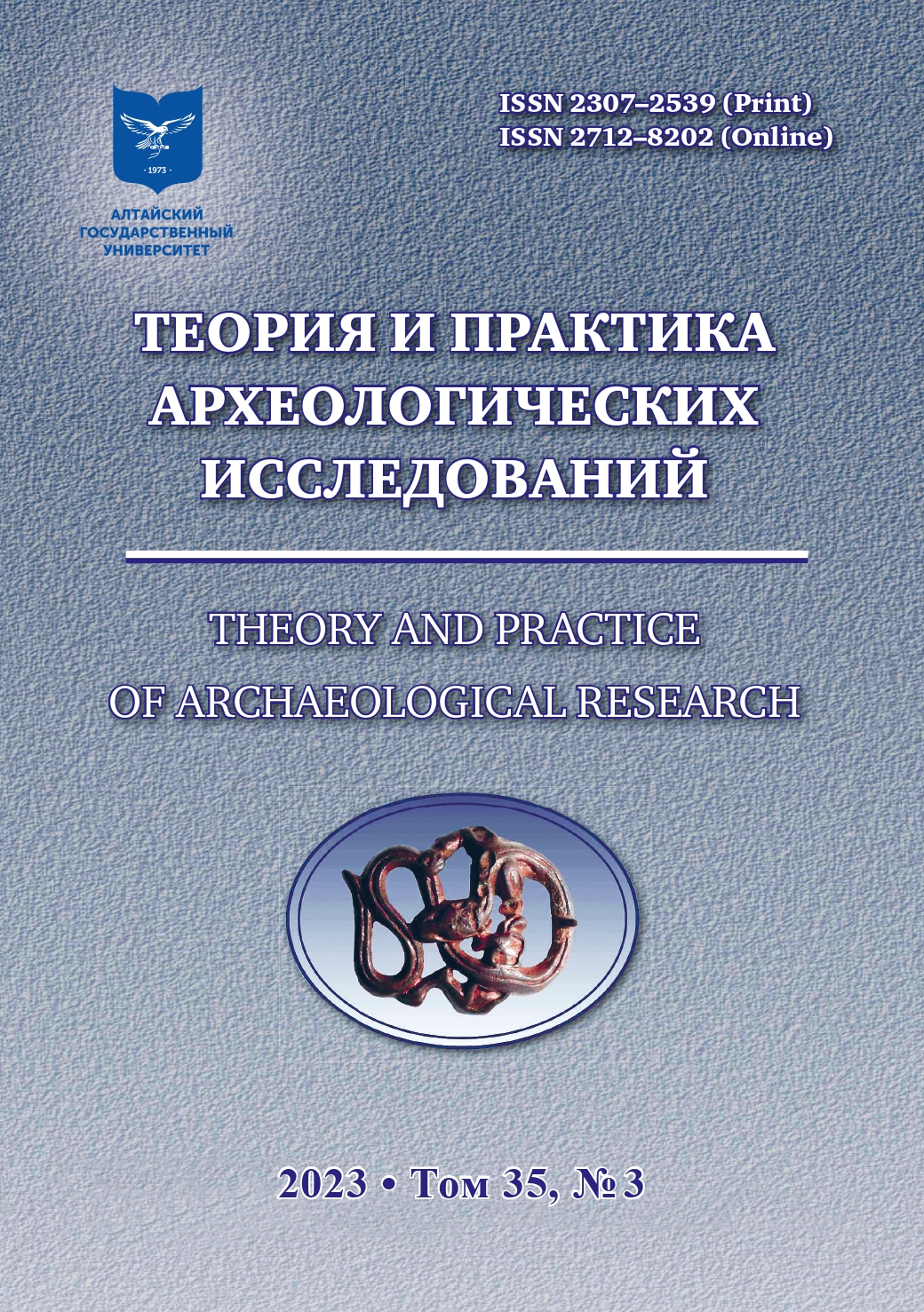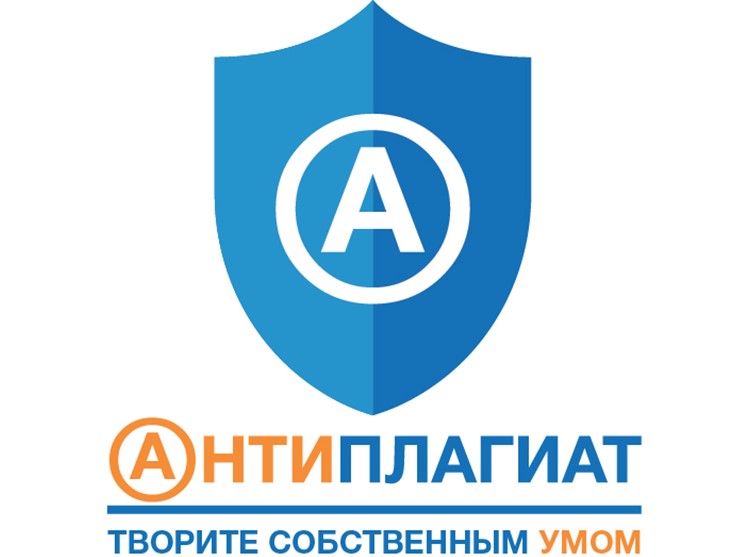CHRONOLOGY OF GRAVES ON STONES FROM THE BASANDAIKA BURIAL MOUND
Abstract
Abstract. The chronology of mounds in the Basandaika Burial Mound was studied by Z.Ya. Boyarshinova, A.P. Dulzon, partially by V.A. Mogilnikov and L.M. Pletneva.
Z.Ya. Boyarshinova stratigraphically divided burials of the Basandaika Burial Mound into upper and lower horizons and identified three seated burials. She dated the burials of the lower horizon to the 10th–12th centuries and the upper horizon to the 13th–14th centuries. However, she did not justify the dating, except for attributing the burials to horizons.
A.P. Dulzon divided all burials of this mound into underground and surface ones. He dated some of the underground burials “mainly to the 12th century, possibly the 11th century”, and some to the 13th–14th centuries. The surface burials were dated to the 13th–14th centuries or possibly later.
L.M. Pletneva dated several burial mounds in the Tomsk Ob Region, including the Basandaika Bural Mound, to the 12th–14th centuries and identified a set of items dating back to the 13th–14th centuries.
Based on this, she attributed some of the burials from the Basandaika Burial Mound to the 13th–14th centuries. The issue of the chronology of the Basandaisky kurgan burial ground remains unresolved till day.
This topic was revisited due to the introduction and processing of a substantial body of sources in scientific research. This paper focuses only on graves on stones (nine in total).
The purpose of the paper is to identify additional details to justify the dating of graves on stones and accurately date them.
Downloads
Metrics
No metrics found.
References
Adamov A.A. Novosibirsk Ob Region in the 10th–14th Centuries. Tobolsk; Omsk : OmGPU, 2000. 256 p. (In Russ.)
Belikova O.B. Middle Chulym Region in the 10th–13th Centuries. Tomsk : Izd-vo Tom. Un-ta, 1996. 272 p. (In Russ.)
Belikova O.B. and Pletneva L.M. The Sites of the Tomsk Ob Region in the 5th–8th Centuries Tomsk : Izd-vo Tom. un-ta, 1983. 244 p. (In Russ.)
Biedermann G. Dictionary of Symbolism. Moscow : Respublika, 1996. 335 p. (In Russ.)
Boyarshinova Z.Ya. Funeral Rituals in the Basandai Mounds. In: Basandaika: Collection of Archaeological Materials and Studies for the Tomsk Region. Tomsk : Tip. №1 Poligrafizdata, 1947. Pp. 151–165 (Proceedings of the Tomsk State University, Vol. 98) (In Russ.)
Gorbunov V.V. Turkification Processes in the South of Western Siberia in the Early Middle Ages. In: Historical Experience of Economic and Cultural Development of Western Siberia. Barnaul : Izd-vo Alt. un-ta, 2003. Vol. 1. Pp. 37–42 (In Russ.)
Gorbunov V.V. Military Arts of the Altai Population in the 3rd–14th Centuries. Part II. Offensive Weapons. Barnaul : Izd-vo Alt. un-ta, 2006. 232 p. (In Russ.)
Gorbunov V.V. Srostki Culture. In: The History of Altai in 3 Volumes. Vol. 1. The Most Ancient Times, Antiquity and the Middle Ages. Barnaul : Izd-vo Alt. un-ta; Belgorod : Konstanta, 2019. Pp. 333–345 (In Russ.)
Gorbunov V.V. and Tishkin A.A. Mounds of the Srostki Culture on the Ob Plateau. Barnaul : Izd-vo Alt. un-ta, 2022. 320 p. (In Russ.)
Gryaznov M.P. The History of Ancient Tribes Based on Excavations Near the Village of Bolshaya Rechka. Мoscow; Leningrad : Izd-vo AN SSSR, 1956. 168 p. (MIA, No. 48). (In Russ.)
Dulzon A.P. Excavation Diaries for the Basandaika Burial Mound. In: Basandaika: Collection of Archaeological Materials and Studies for the Tomsk Region. Tomsk : Tip. №1 Poligrafizdata, 1947а [cover: 1948]. Pp. 65–116 (Proceedings of the Tomsk State University, Vol. 98) (In Russ.)
Dulzon A.P. Excavation Diaries for the Basandaika Burial Mound. In: Archive of the TSU Museum of Siberian Archaeology and Ethnography. 1947b. No. 106 (In Russ.)
Dulzon A.P. Excavation Diaries for the Basandaika Burial Mound. 1944–1946. The United Historical and Archaeological Expedition of the Tomsk State University and the Tomsk State Pedagogical Institute. Tomsk, 1944, 1945, 1946. Research Repository of the Institute of Archaeology of the Russian Academy of Sciences. F-1. P. No. 50. 177 (In Russ.)
Dulzon A.P. Late Archaeological Sites and the Problem of the Origin of the Chulym Tatars. In: Proceedings of the Western Tomsk State Pedagogical University. Vol. 10. Tomsk, 1953. Pp. 127–334 (In Russ.)
Ivanov V.A. and Kriger V.A. Mounds of the Kipchak Period in the Southern Ural (12th–14th Centuries). Moscow : Nauka, 1988. 92 p. (In Russ.)
Ilyushin A.M. The Ethnocultural History of the Kuznetsk Depression in the Middle Ages. Kemerovo : Izd-vo KuzGTU, 2005. 240 p. (In Russ.)
Kovalevskaya V.B. The North Caucasus in the 10th–13th Centuries. In: Steppes of Eurasia in the Middle Ages. Moscow : Nauka, 1981. Pp. 224–228 (In Russ.)
Kyzlasov I.L. The Askiz Culture. The Khakass in the Middle Ages in the 10th–14th Centuries. In: Steppes of Eurasia in the Middle Ages. Moscow : Nauka, 1981. Pp. 200–207 (In Russ.)
Kyzlasov I.L. The Askiz Culture of Southern Siberia of the 10th–14 Centuries. Moscow : Nauka, 1983. Issue E3-18. 128 p. (In Russ.)
Kyzlasov L.R. The Tyukhtyat Culture of the Khakass in the Middle Ages (9th–10th Centuries). In: Steppes of Eurasia in the Middle Ages. Moscow : Nauka, 1981. Pp. 54–59 (In Russ.)
Lubo-Lesnichenko E.I. Imported Mirrors of the Minusinsk Basin: To the question of external relations of the ancient population of South Siberia. With an appendix of an article by I.V. Bogdanova-Berezovskaya. Moscow : Nauka, 1975. 164 p. (In Russ.)
Marakuev A.V. Chinese Bronzes from Basandaika. In: Basandaika: Collection of Archaeological Materials and Studies for the Tomsk Region. Tomsk : Tip. №1 Poligrafizdata, 1947а [cover: 1948]. Pp. 167–174 (Proceedings of the Tomsk State University, Vol. 98) (In Russ.)
Medvedev A.F. Throwing Weapons (Bow and Arrows, Crossbow). Moscow : Nauka, 1966. 184 p. (SAI. Issue Е1-36). (In Russ.)
Medvedev V.E. The Amur Region at the End of the 1st — Beginning of the 2nd Millennium AD. Jurchen Era. Novosibirsk : Nauka, 1986. 205 p. (In Russ.)
Mogilnikov V.A. On the Ethnic Composition of the Middle and Upper Ob Region in the 1st Millennium AD. In: Peoples and Languages of Siberia. Novosibirsk : Nauka, 1980. Pp. 242–248 (In Russ.)
Mogilnikov V.A. Monuments of the Nomads of Siberia and Central Asia in the 10th–12th Centuries. In: Steppes of Eurasia in the Middle Ages. Moscow : Nauka, 1981. Pp. 190–193 (In Russ.)
Mogilnikov V.A. Siberian and Central Asian Nomadic Antiquities of the 11th–14th Centuries. In: Steppes of Eurasia in the Middle Ages. Moscow : Nauka, 1981. Pp. 194–200 (In Russ.)
Mogilnikov V.A. Yudina Culture. In: Finno-Ugrians and Balts in the Middle Ages. Moscow : Nauka, 1987. Pp. 168–176 (In Russ.)
Mogilnikov V.A. Nomads of the Northwestern Foothills of the Altai Mountains in the 9th–11th Centuries. Moscow : Nauka, 2002. 362 p. (In Russ.)
Molodin V.I., Efremova N.S. and Solovyov A.I. Sopka-2 Site on the Om River. Vol. 6. Ritual Complexes of the Middle Ages. Novosibirsk : Izd-vo In-ta arheologii i etnografii SO RAN, 2021. 143 p. (In Russ.)
Molodin V.I., Sobolev V.I. and Solovyov A.I. Baraba in the Late Middle Ages. Novosibirsk : Nauka, 1990. 262 p. (In Russ.)
Molodin V.I. and Solovyov A.I. Sopka-2 Monument on the Om River. Vol. 2. Cultural and Chronological Analysis of Burial Complexes of the Middle Ages. Novosibirsk : Izd-vo In-ta arheologii i etnografii SO RAN, 2004. 184 p. (In Russ.)
Nikolaev V.S. Burial Complexes of Nomads in the South of Central Siberia in the 12th–14th Centuries: Ust-Talka Culture. Vladivostok ; Irkutsk : Izd-vo In-ta geografii SO RAN, 2004. 306 p. (In Russ.)
Novikov A.V. Tashara-Karyer-2 Burial Mound. In: Upper Ob Region at the Turn of the Ages (Basandaika Culture). Chapter 3. Novosibirsk : Izd-vo In-ta arheologii i etnografii SO RAN, 2008. Pp. 276–337 (In Russ.)
Pletneva L.M. Tomsk Ob Region in the Early Second Millennium AD (Based on Archaeological Data). Tomsk : Izd-vo TGU, 1997. 350 p. (In Russ.)
Pletneva L.M. Lazurite in Jewelry from Site of the Basandaika Culture. Narody i religii Evrazii = Peoples and Religions of Eurasia. 2019;3(20):34–58 (In Russ.)
Pletneva L.M. Social Structure of the Population of the Tomsk Ob Region in the High Middle Ages (Based on Materials from Burial Grounds). Teorija i praktika arheologicheskih issledovanij = Theory and Practice of Archaeological Research. 2021;33(1):106–127 (In Russ.)
Pletneva L.M. The Orientation of Bodies Buried in Mounds of the Tomsk Ob Region of the High Middle Ages. Teorija i praktika arheologicheskih issledovanij = Theory and Practice of Archaeological Research. 2022a;34(1):95–108 (In Russ.)
Pletneva L.M. Burial Structures of the High Middle Ages in the Tomsk Ob Region (Based on Materials from Burial Grounds). Teorija i praktika arheologicheskih issledovanij = Theory and Practice of Archaeological Research. 2022b;34(2):105–134 (In Russ.)
Pletneva S.A. The Pechenegs, Torks and Cumans in the South Russian Steppes. Moscow; Leningrad ; Izd-vo AN SSSR, 1958. Pp. 151–226 (MIA, №62). (In Russ.)
Roslyakov S.G. Sanatorny-1 Burial Mound. In: Upper Ob Region at the Turn of the Ages (Basandaika Culture). Novosibirsk : Izd-vo Instituta arheologii i etnografii SO RAN, 2008. Pp. 71–275 (In Russ.)
Savinov D.G. The Peoples of Southern Siberia in the Ancient Turkic Era. Leningrad : Izd-vo Leningr. un-ta, 1984. 175 p. (In Russ.)
Savinov D.G. States and Cultural Genesis in Southern Siberia in the Early Middle Ages. Kemerovo : Kuzbassvuzizdat, 1994. 215 p. (In Russ.)
Sedova M.V. Jewelry of Ancient Novgorod (10th–15th Centuries). Moscow : Nauka, 1981. 195 p. (In Russ.)
Tishkin A.A. Creation of Periodization and Cultural Chronological Charts: Historical Experience and Modern Approach to Studying Ancient and Medieval Altai Peoples. Barnaul : Izd-vo Alt. un-ta, 2007. 350 p. (In Russ.)
Tishkin A.A. The Altai Region in the Mongolian Period (Based on the Materials from Archaeological Monuments). Barnaul : Azbuka, 2009. 208 p. (In Russ.)
Tishkin A.A., Gorbunov V.V. and Kazakov A.A. Teleuisky Vzoz-1 Kurgan Burial Ground and the Culture of the Population of the Forest-Steppe Altai in the Mongolian Agw. Barnaul : Izd-vo Alt. un-ta, 2002. 276 p. (In Russ.)
Trifonov Yu.I. The Sites of Medieval Nomads. In: Archaeological Sites in the Flood Zone of the Shulbinskaya HPP. Alma-Ata : Nauka, 1987. Pp. 115–246. (In Russ.)
Trifonov Yu.I., Akhinzhanov S.M. and Ermolaeva A.S. Belokamenka. In: Archaeological Sites in the Flood Zone of the Shulbinskaya HPP. Alma-Ata : Nauka, 1987. Pp. 141–144 (In Russ.)
Trifonov Yu.I. and Samashev Z.S. Karashat-1. In: Archaeological Sites in the Flood Zone of the Shulbinskaya HPP. Alma-Ata : Nauka, 1987. Pp. 176–215 (In Russ.)
Troitskaya T.N. and Novikov A.V. The Upper Ob Culture in the Novosibirsk Ob Region. Novosibirsk : Izd-vo In-ta arheologii i etnografii SO RAN, 1998. 152 p. (In Russ.)
Fedorov-Davydov G.A. Nomads of Eastern Europe under the Rule of the Golden Horde Khans. Moscow : Izd-vo MGU, 1966. 273 p. (In Russ.)
Khudyakov Yu.S. Armament of the Yenisei Kyrgyz in the 6th–12th Centuries. Novosibirsk : Nauka, 1980. 176 p. (In Russ.)
Khudyakov Yu.S. Armament of Nomads of Southern Siberia and Central Asia in the High Middle Ages. Novosibirsk : Izd-vo in-ta arheologii i etnografii SO RAN, 1997. 160 p. (In Russ.)
Copyright (c) 2023 Л.М. Плетнева

This work is licensed under a Creative Commons Attribution 4.0 International License.
Theory and Practice of Archaeological Research is a golden publisher, as we allow self-archiving, but most importantly we are fully transparent about your rights.
Authors may present and discuss their findings ahead of publication: at biological or scientific conferences, on preprint servers, in public databases, and in blogs, wikis, tweets, and other informal communication channels.
Theory and Practice of Archaeological Research allows authors to deposit manuscripts (currently under review or those for intended submission to ABS) in non-commercial, pre-print servers such as ArXiv.
Authors who publish with this journal agree to the following terms:
- Authors retain copyright and grant the journal right of first publication with the work simultaneously licensed under a Creative Commons Attribution License (CC BY 4.0) that allows others to share the work with an acknowledgement of the work's authorship and initial publication in this journal.
- Authors are able to enter into separate, additional contractual arrangements for the non-exclusive distribution of the journal's published version of the work (e.g., post it to an institutional repository or publish it in a book), with an acknowledgement of its initial publication in this journal.
- Authors are permitted and encouraged to post their work online (e.g., in institutional repositories or on their website) prior to and during the submission process, as it can lead to productive exchanges, as well as earlier and greater citation of published work (See The Effect of Open Access).








2.jpg)




